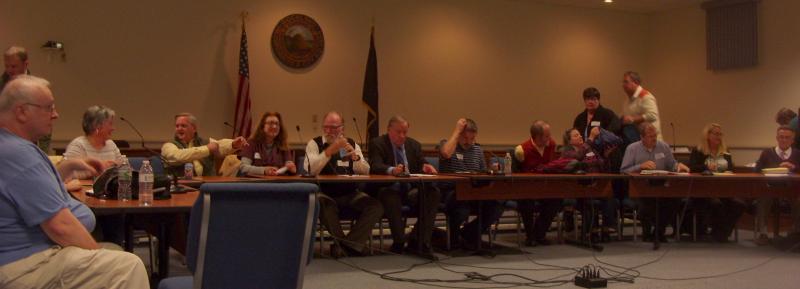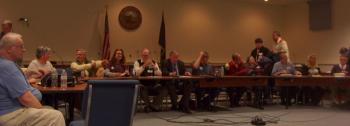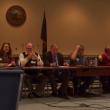Rockland urged to slow down withdrawal consideration; RSU 13 urged to be more specific in consolidation plan
ROCKLAND — Over the past year, a petition spearheaded by Tess Kilgour was initiated to support a citizen’s initiative to withdraw from RSU 13. In the beginning, random signatures would appear. But after this April’s budget cycle, in which voters were subject to an 18 percent tax increase for education, signatures to the petition rapidly increased to the amount necessary for inclusion on the November ballot.
With questions ready for voter approval next Tuesday, the City of Rockland is now faced with trying to help voters consider what’s in the best interest of community, children, education, and taxes.
The intention behind a special meeting Tuesday, Oct. 27, in Rockland’s council chambers and which assembled RSU 13 school board members with municipal officials, aimed to do what St. George spent two years researching before withdrawal.
Instead of answering Rockland’s questions, however, representatives for the other four municipalities comprising the district vocalized their own concerns regarding the proposed efficiency plan.
This plan, if approved by school board members on November 5, would set into motion a series of constructions, renovations, and moves — some of which would commence within the next 12 months.
Jan Gaudio, chairman of South Thomaston’s board of selectmen, echoed the sentiments of many at the table as he spoke of Guilford Butler School’s unhappiness with the status quo. Yet, despite finding no fault with RSU 13 Superintendent John McDonald and his plans for consolidation and curriculum restructure, officials doubted citizens would approve a consolidation plan without specific details and cost.
Those details and costs will not be possible until after the board — then the citizens — agree to allow the status quo to change. When and if this happens, the board, the citizens, and consulting engineers will commit to — or change — any of the smaller projects within the general proposal.
McDonald, who was hired a year and a half ago and immediately tasked with creating an improvement plan, said that currently “our facilities have been woefully under maintained. We’re spending a lot of money fixing things that break.”
McDonald referenced the poor ventilation system at Rockland’s Oceanside High School. Either staff open the windows in February to let the 95-degree heat out, or the students fall asleep due to the carbon dioxide build up.
He mentioned that this high school has no kitchen. Lunches are prepared at Rockland District Middle School before transport to the “biggest school in the district,” according to McDonald.
RSU 13 Business Manager Peter Orne gave estimates of how money from consolidation and energy savings could be used for future payments elsewhere. If there is no building, there is no heat bill or custodial salary to pay. Orne pointed to a $250,000 to $275,000 energy savings, along with trying to identify about $500,000 to $600,000 in consolidation savings.
The district is also looking for grant funding and other resources to help with the potential $13 million project cost of the school facilities, which are all owned by RSU 13.
The Schools of Our Future proposal happens to come just as most Rocklanders are now able to officially consider withdrawal. Kilgour cited several unfulfilled promises by previous superintendents in the past seven years.
If Rockland withdraws, the consolidation proposal would be shelved due to apprehension by financial lenders should other towns withdraw in the future, according to McDonald.
Kilgour’s presentation of increased taxes and previous proposals being slated was countered by officials of other towns accusing Rockland of generating chaos and uncertainty. According to one official, Rockland is out to harm students and intellectual life.
Reach Sarah Thompson at news@penbaypilot.com.
Event Date
Address
United States
























